|
This page describes the 25 classes of isohedra with a finite number of sides.
Many of these don't have standard names, though specific examples of a particular class may.
So instead I use a simple notation to describe each isohedral class.
- First the number of sides: 4, 6, 8, 12, 20, 24, 30, 48, 60 or 120
- Second, a description of the sides:
- if it's a Platonic solid or it's made from raising triangles on the sides of a Platonic solid, an upper case letter representing the base shape - T: tetrahedron, O: octahedron, C: cube, D: dodecahedron, I: icosahedron
- otherwise, a lower case letter representing the face shape - i: isosceles triangle, s: scalene triangle, r: rhombus, k: kite, q: quadrilateral with two adjacent equal sides, y: "pyrite" pentagon with 4 equal sides and bilateral symmetry, p: pentagon with two pairs of adjacent equal sides
Not described here are the 5 classes of isohedra with an infinite number of possible sides:
- The dipyramid (aka bipyramid), with 2n triangular sides
- The trapezohedron, with 2n quadrilateral sides
- The skewed trapezoidal dihedron (aka trigonal trapezohedron), with 2n quadrilateral sides
- The triangular dihedron skewed up/down (aka scalenohedron), with 4n triangular sides
- The triangular dihedron skewed in/out, with 4n triangular sides
4T
| Known as: |
tetrahedron
|
| Categories: |
Platonic solid, crystallography
|
| Specific form: |
tetrahedron made from 4 equilateral triangles
|
| transform: |
4t(0.333, 0.577), 4t(3, 1.732), 4q(0.333, 0.5), 4q(1, 0.5), 4p(a, 0), 4p(0.5, a)
|
|

|
| General form: |
none
|
4i
| Known as: |
isosceles tetrahedron, tetragonal disphenoid
|
| Categories: |
crystallography
|
| Specific form: |
4T is a special case
|
| General form: |
tetrahedron with isosceles triangular faces where each edge is the diagonal of a cuboid
|
| transform: |
4d(a, a), 4d(1, a), 4d(a, 1)
|
|


|
4s
| Known as: |
scalene tetrahedron, rhombic disphenoid
|
| Categories: |
crystallography
|
| Specific form: |
4i is a special case
|
| General form: |
tetrahedron with scalene triangular faces where each edge is the diagonal of a cuboid
|
| transform: |
4d(a, b)
|
|


|
6C
| Known as: |
cube, hexahedron, dual of the octahedron
|
| Categories: |
Platonic solid, crystallography
|
| Specific form: |
cube made from 6 squares
|
| transform: |
4t(1, 0.577), 4p(a, 1.636a), 8t(1.732, 1.414), 8q(0.5, 0.5), 8p(0.5, a)
|
|

|
| General form: |
none
|
8O
| Known as: |
octahedron, dual of the cube
|
| Categories: |
Platonic solid, crystallography
|
| Specific form: |
octahedron made from 8 equilateral triangles
|
| transform: |
8t(0.577, 0.707), 8q(1, a), 8p(a, 0)
|
|

|
| General form: |
none
|
12T
| Known as: |
triakis tetrahedron, tristetrahedron, trigonal tristetrahedron, cumulation of the tetrahedron, dual of the truncated tetrahedron
|
| Categories: |
Catalan solid, Archimedean dual, crystallography
|
| Specific form: |
dual of the truncated tetrahedron
|
| transform: |
4t(0.675, 0.577), 4t(1.481, 0.854)
|
|

|
| General form: |
made by raising or lowering the center of each face of a tetrahedron an equal distance
|
| transform: |
4t(a,0.577), 4t(a, 0.577a)
|
|





|
| Interesting examples: |
equilateral stellated tetrahedron: 4t(1.667, 0.571).
All edges have the same length.
|
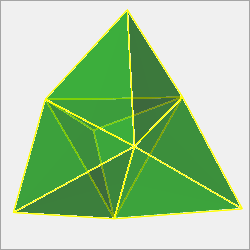
|
|
12r
| Known as: |
rhombic dodecahedron, dual of the cuboctahedron
|
| Categories: |
Catalan solid, Archimedean dual, crystallography
|
| Specific form: |
made from 12 rhombi
|
| transform: |
4t(1, 1.155), 4q(0.5, 0.5), 8t(0.866, 0.707), 8q(a, 1-a) as a->0, 8p(a, a)
|
|

|
| General form: |
none
|
12k
| Known as: |
trapezoidal dodecahedron, trapezohedral tristetrahedron
|
| Categories: |
crystallography
|
| Specific form: |
none
|
| General form: |
made from 12 kite shaped quadrilaterals
|
| transform: |
4t(a, f(a)), 4q(a, 0.5)
|
|




|
12D
| Known as: |
dodecahedron, regular dodecahedron, dual of the icosahedron
|
| Categories: |
Platonic solid
|
| Specific form: |
made from 12 regular pentagons
|
| transform: |
4p(0.405, 0.156), 8q(0.722, 0.278), 20t(1.258, 1.176), 20q(0.7236, 0.5), 20p(0.5, a)
|
|

|
| General form: |
none
|
12y
| Known as: |
octahedral pentagonal dodecahedron, pentagonal dodecahedron, pyritohedron
|
| Categories: |
crystallography
|
| Specific form: |
the regular dodecahedron is a special case
|
| General form: |
made from 12 pentagons with 4 equal sides and bilateral symmetry
|
| transform: |
4p(a, 0.818(1-2a)), 8q(a, 1-a)
|
|










|
| Interesting examples: |
non-convex equilateral pyritohedron: 4p(0.09549150, 0.6605596).
This is interesting because all the edges have the same length.
|

|
|
12p
| Known as: |
tetragonal pentagonal dodecahedron, tetartoid
|
| Categories: |
crystallography
|
| Specific form: |
12y is a special case
|
| General form: |
made from 12 pentagons that have two pairs of equal adjacent sides
|
| transform: |
4p(a, b)
|
|






|
20I
| Known as: |
icosahedron, dual of the dodecahedron
|
| Categories: |
Platonic solid
|
| Specific form: |
made from 20 equilateral triangles
|
| transform: |
20t(0.795, 0.851), 20q(1, 0.5), 20p(a, 0)
|
|

|
| General form: |
none
|
24O
| Known as: |
triakis octahedron, small triakis octahedron, trisoctahedron, trigonal trisoctahedron, cumulation of the octahedron, dual of the truncated cube
|
| Categories: |
Catalan solid, Archimedean dual, crystallography
|
| Specific form: |
dual of the truncated cube
|
| transform: |
8t(0.717, 0.707)
|
|

|
| General form: |
made by raising or lowering the center of each face of a octahedron an equal distance
|
| transform: |
8t(a, 0.707)
|
|



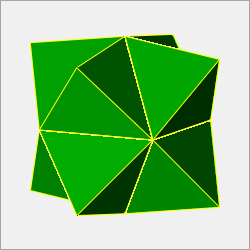

|
| Interesting examples: |
equilateral triakis octahedron, stellated octahedron, stella octangula: 8t(1.732, 0.707).
All edges have the same length.
|

|
|
24C
| Known as: |
tetrakis hexahedron, tetrahexahedron, cumulation of the cube, dual of the truncated octahedron
|
| Categories: |
Catalan solid, Archimedean dual, crystallography
|
| Specific form: |
dual of the truncated octahedron
|
| transform: |
4t(1, 0.866), 8t(1.155, 0.943)
|
|
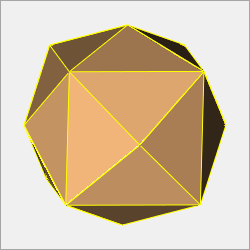
|
| General form: |
made by raising or lowering the center of each face of a cube an equal distance
|
| transform: |
4t(1, a), 8t(a, a*sqrt(2/3))
|
|




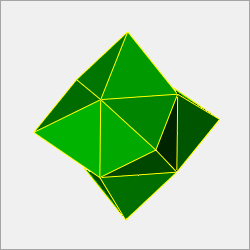
|
| Interesting examples: |
equilateral tetrakis hexahedron, stellated cube, a Mobius deltahedron: 8t(0.717, 0.586).
All edges have the same length.
|

|
|
24T
| Known as: |
hexakis tetrahedron, hextetrahedron
|
| Categories: |
crystallography
|
| Specific form: |
none
|
| General form: |
made by changing the length of the face axes and edge-midpoint axes of a tetrahedron
|
| transform: |
4t(a, b)
|
|






|
| Interesting examples: |
equilateral hexakis tetrahedron, a Mobius deltahedron: 4t(0.2251485, 1.061010).
All edges have the same length.
|

|
|
24k
| Known as: |
trapezoidal icositetrahedron, strombic icositetrahedron, trapezohedral trisoctahedron, trapezohedron, dual of the rhombicuboctahedron
|
| Categories: |
Catalan solid, Archimedean dual, crystallography
|
| Specific form: |
dual of the rhombicuboctahedron
|
| transform: |
8t(0.947, 1), 8q(0.707, 0.5)
|
|

|
| General form: |
made from 24 kite shaped quadrilaterals
|
| transform: |
8t(a, f(a)), 8q(a, 0.5)
|
|

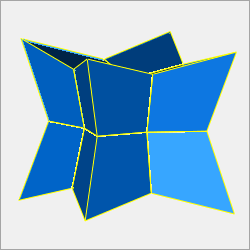



|
24q
| Known as: |
dyakis dodecahedron, didodecahedron, diploid
|
| Categories: |
crystallography
|
| Specific form: |
none
|
| General form: |
made from 24 quadrilaterals with only two equal and adjacent sides
|
| transform: |
8q(a, b)
|
|

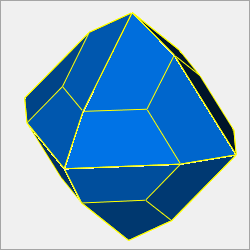




|
24p
| Known as: |
pentagonal icositetrahedron, pentagon trioctahedron, gyroid, dual of the snub cube
|
| Categories: |
Catalan solid, Archimedean dual, crystallography
|
| Specific form: |
dual of the snub cube
|
| transform: |
8p(0.419643, 0.124064)
|
|

|
| General form: |
made from 24 pentagons that have two pairs of equal adjacent sides
|
| transform: |
8p(a, b)
|
|






|
| Interesting examples: |
bilateral pentagonal icositetrahedron: 8p(0.4301597, 0.2451223).
This one is interesting in that the faces have bilateral symmetry,
though it's different from the pentagonal icositetrahedron Catalan solid, which also has faces with bilateral symmetry.
|

|
equilateral pentagonal icositetrahedron: 8p(0.3456397, 0.03187700).
All the edges are the same length.
|

|
non-convex equilateral pentagonal icositetrahedron: 8p(0.05625923, 0.42629483).
This one also has edges that are all the same length.
|

|
|
30r
| Known as: |
rhombic triacontahedron, dual of the icosidodecahedron
|
| Categories: |
Catalan solid, Archimedean dual
|
| Specific form: |
made from 30 rhombi
|
| transform: |
20t(0.911, 0.851), 20p(a, a * 0.65)
|
|

|
| General form: |
none
|
48O
| Known as: |
hexakis octahedron, disdyakis dodecahedron, hexoctahedron, octakis hexahedron, dual of the truncated cuboctahedron
|
| Categories: |
Catalan solid, Archimedean dual, crystallography
|
| Specific form: |
dual of the truncated cuboctahedron
|
| transform: |
8t(0.916, 0.867)
|
|

|
| General form: |
made by changing the length of the face axes and edge-midpoint axes of an octahedron
|
| transform: |
8t(a, b)
|
|






|
| Interesting examples: |
equilateral hexakis octahedron, a Mobius deltahedron: 8t(0.4279334, 1.141839).
All edges have the same length.
|

|
equilateral hexakis octahedron, a Mobius deltahedron: 8t(1.013122, 0.109977).
All edges have the same length.
|

|
|
60I
| Known as: |
triakis icosahedron, cumulation of the icosahedron, dual of the truncated dodecahedron
|
| Categories: |
Catalan solid, Archimedean dual
|
| Specific form: |
dual of the truncated dodecahedron
|
| transform: |
20t(0.855, 0.851)
|
|

|
| General form: |
made by raising or lowering the center of each face of an icosahedron an equal distance
|
| transform: |
20t(a, 0.851)
|
|





|
60D
| Known as: |
pentakis dodecahedron, cumulation of the dodecahedron, dual of the truncated icosahedron
|
| Categories: |
Catalan solid, Archimedean dual
|
| Specific form: |
dual of the truncated icosahedron
|
| transform: |
20t(1.027, 0.959)
|
|

|
| General form: |
made by raising or lowering the center of each face of a dodecahedron an equal distance
|
| transform: |
20t(a, a*0.934)
|
|

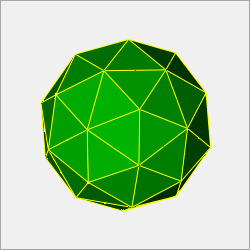



|
60k
| Known as: |
trapezoidal hexecontahedron, strombic hexecontahedron, dual of the rhombicosidodecahedron
|
| Categories: |
Catalan solid, Archimedean dual
|
| Specific form: |
dual of the rhombicosidodecahedron
|
| transform: |
20t(0.957, 0.975), 20q(0.873, 0.5)
|
|

|
| General form: |
made from 60 kite shaped quadrilaterals
|
| transform: |
20t(a, f(a)), 20q(a, 0.5)
|
|





|
| Interesting examples: |
rhombic hexecontahedron: 20q(0.5, 0.5).
Each face is a rhombus.
|

|
|
60p
| Known as: |
pentagonal hexecontahedron, dual of the snub dodecahedron
|
| Categories: |
Catalan solid, Archimedean dual
|
| Specific form: |
dual of the snub dodecahedron
|
| transform: |
20p(0.425584, 0.0886258)
|
|

|
| General form: |
made from 60 pentagons that have two pairs of equal adjacent sides
|
| transform: |
20p(a, b)
|
|

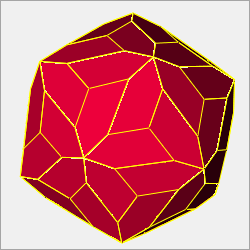


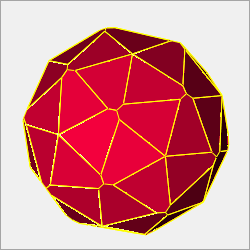

|
| Interesting examples: |
bilateral pentagonal hexecontahedron: 20p(0.4647861, 0.2504700).
The faces have bilateral symmetry,
though it's different from the pentagonal hexecontahedron Catalan solid, which also has faces with bilateral symmetry.
|

|
non-convex equilateral pentagonal hexecontahedron: 20p(0.3140921, -0.04663939).
All the edges are the same length.
|

|
non-convex equilateral pentagonal hexecontahedron: 20p(0.03413652, 0.2976625).
This one also has edges that are all the same length.
|

|
|
120I
| Known as: |
hexakis icosahedron, disdyakis triacontahedron, dual of the truncated icosidodecahedron
|
| Categories: |
Catalan solid, Archimedean dual
|
| Specific form: |
dual of the truncated icosidodecahedron
|
| transform: |
20t(0.938, 0.921)
|
|

|
| General form: |
made by changing the length of the face axes and edge-midpoint axes of an icosahedron
|
| transform: |
20t(a, b)
|
|






|
| Interesting examples: |
equilateral hexakis icosahedron, a Mobius deltahedron: 20t(0.650328, 1.18675).
All edges have the same length.
|

|
equilateral hexakis icosahedron, a Mobius deltahedron: 20t(1.06090, 0.446900).
All edges have the same length.
|

|
|
Fair dice
|





























































































































